Most Greek Paintings Still Exist Today and Are in Art Museums
In our modern era, very little is known about the ancient Greek painters and the Greek paintings they produced. Classical Greek artworks that still exist today are mostly sculptures, architecture, and some vases, simply very few ancient Greek paintings even fabricated it into the 20th century. So, what was pregnant about Greek paintings, and why do we know so footling virtually the painting attribute of the Greek arts?
Tabular array of Contents
- i An Introduction to Greek Paintings
- 1.1 What Was Pregnant About Greek Paintings?
- i.2 Famous Ancient Greek Painters
- 2 Famous Ancient Greek Paintings
- 2.1 Akrotiri Frescoes (c. 1700 BCE)
- 2.2 Pitsa Panels (c. 540 – 530 BCE)
- 2.3 Achilles and Ajax Playing (540 – 530 BCE)
- two.4 Euphronios Krater (c. 515 BCE)
- 2.5 Tomb of the Diver at Paestum (c. 470 BCE)
- 2.6 The Siren Vase (480 – 470 BCE)
- 2.seven Philip II Tomb (c. 4th century BCE)
- 3 Ofttimes Asked Questions
- 3.1 What Was Pregnant Virtually Greek Paintings?
- 3.2 Where Can Ancient Greek Paintings All the same Be Seen?
An Introduction to Greek Paintings
There are very few examples of ancient Greek paintings left for us to admire, and near of what we practice know about the aboriginal Greek painters and their artworks comes from written descriptions. As with other Greek arts, much of what we have left today are Roman replications of the original Greek artworks that accept been lost to time. These copies, however, requite us much insight into the styles and techniques that were employed by the ancient Greek painters.
What Was Significant About Greek Paintings?
Aboriginal historians such as Pausanias and Pliny take stated that console paintings were the almost respected and mutual art form of the aboriginal Greek period. These depicted still-lifes and portraits painted in tempera and encaustic wax. Unfortunately, non even copies be from the very early period due to the perishable nature of the medium, and political too as environmental factors too destroyed many of them.
Many of the surviving ancient Greek paintings are those that had been painted on structures that would stand against the harsh elements over time, such equally murals and wall paintings in the temples and tombs of Greece and Rome.
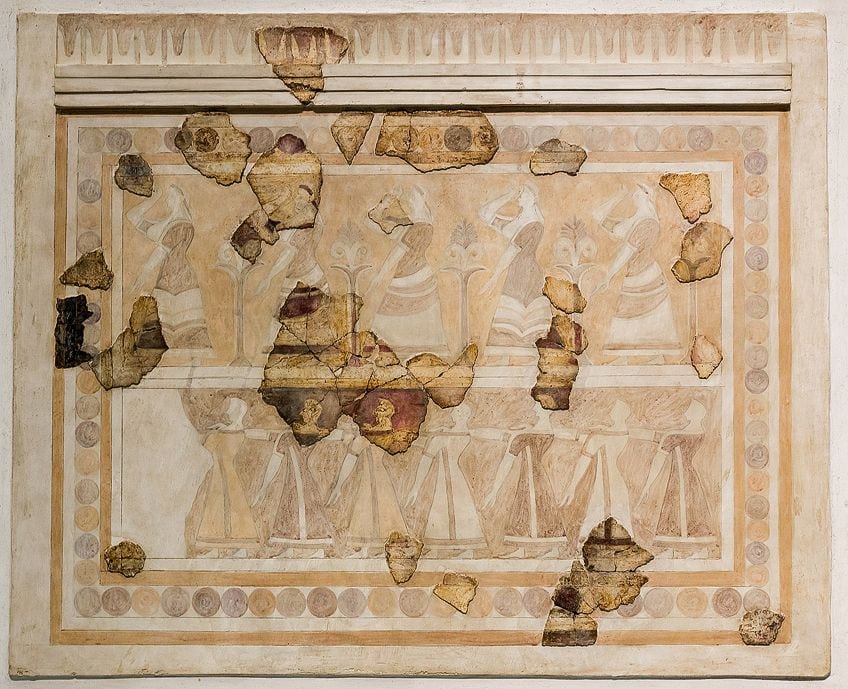 Wall painting of a procession of women from Hagia Triada. Depicted above are five women with their right hands raised to their head, maybe as a gesture of mourning. Below are another seven women, walking in the same management every bit those above, each laying her correct hand on the shoulder of the woman in front of her, c. 1450-1350/1300 BC. Found at a Minoan villa in Hagia Triada;ArchaiOptix, CC By-SA iv.0, via Wikimedia Commons
Wall painting of a procession of women from Hagia Triada. Depicted above are five women with their right hands raised to their head, maybe as a gesture of mourning. Below are another seven women, walking in the same management every bit those above, each laying her correct hand on the shoulder of the woman in front of her, c. 1450-1350/1300 BC. Found at a Minoan villa in Hagia Triada;ArchaiOptix, CC By-SA iv.0, via Wikimedia Commons
Many of the Greek sculptures were besides originally painted in bright and brilliant colors, in a technique known as polychromy. Almost of the time, the pigment was used to color article of clothing and hair, and the skin was left the natural color of the statue stone, although there are also examples where the skin has been painted a low-cal brown color. Another useful source for learning well-nigh the techniques of the aboriginal Greek painters is from the ceramic vases that were discovered in Etruscan tombs.
Although not made past the Greeks themselves, they were imitations of the way of ancient Greek paintings and therefore yet impart useful information to u.s. most the early days of the Greek arts.
Famous Ancient Greek Painters
Most no paintings still exist that were originally created by the aboriginal painters of Classical Greek fine art. Although there has been much written about the artists and their art, we do not take many examples beyond a few frescoes and vases, and the descriptions of ancient historians. However, information technology is still useful to give y'all some information about the creators of these lost treasures.
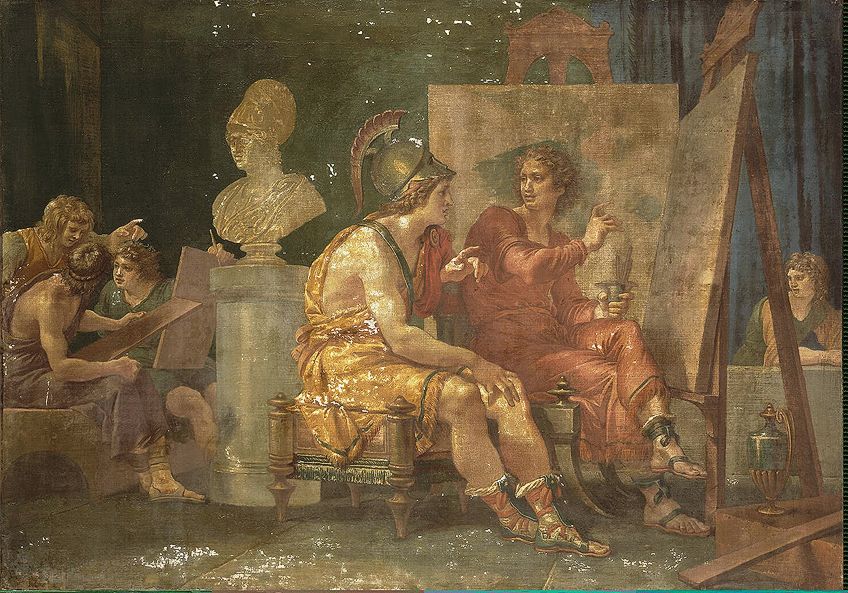 Alexander the Slap-up in the Workshop of Apelles(1792) by Giuseppe Cades, depicting Alexander the Cracking in the painting workshop of the famous ancient Greek painter, Apelles;Giuseppe Cades, Public domain, via Wikimedia Eatables
Alexander the Slap-up in the Workshop of Apelles(1792) by Giuseppe Cades, depicting Alexander the Cracking in the painting workshop of the famous ancient Greek painter, Apelles;Giuseppe Cades, Public domain, via Wikimedia Eatables
Cimon of Cleone (c. 8th to 6th century BCE)
Cimon of Cleone is so ancient a Greek painter that historians aren't fifty-fifty certain what century he was born in! One of the primeval Greek painters, he was most well-known for his unique depictions of the human figure. He employed a technique that was not heard of at the time where he would foreshorten his objects to create a sense of perspective.
He is also said to be the first artist to paint figures that looked effectually as opposed to just straight ahead, a style known as Catagrapha.
Agatharchus (c. 5th century BCE)
Agatharcus was born on the isle of Samos in the 5th century BCE. He is noted as the offset artist to apply perspective on a large calibration, and besides pioneered the idea of bringing out the shadows of objects by placing them confronting the lord's day. He is credited with bringing the concepts of illusion and perspective to scenic painting. His most famous artwork was the backdrop he painted for the play Vii Confronting Thebes by Aeschylus.
Apollodorus (c. 5th century BCE)
Apollodorus is considered to be one of the most influential painters from the 5th century in Greece. He was known for his masterful employ of shadows in his compositions, known every bit Skiagraphia. This technique would influence the artists of later periods, such as the painters of the Italian Renaissance who further adult the technique of having night and well-lit elements of a limerick, known as chiaroscuro.
Zeuxis (c. 5th century BCE)
Zeuxis was born in Heraclea in Southern Italy sometime during the 5th century and was an ancient Greek painter that was revered for his ability to pigment notwithstanding-lifes with bang-up realism. Although Apollodorus had created the shadow technique, it was perfected by Zeuxis, and his use of light and shadow helped create volumetric illusion instead of the flat appearance of the aboriginal Greek paintings of other artists.
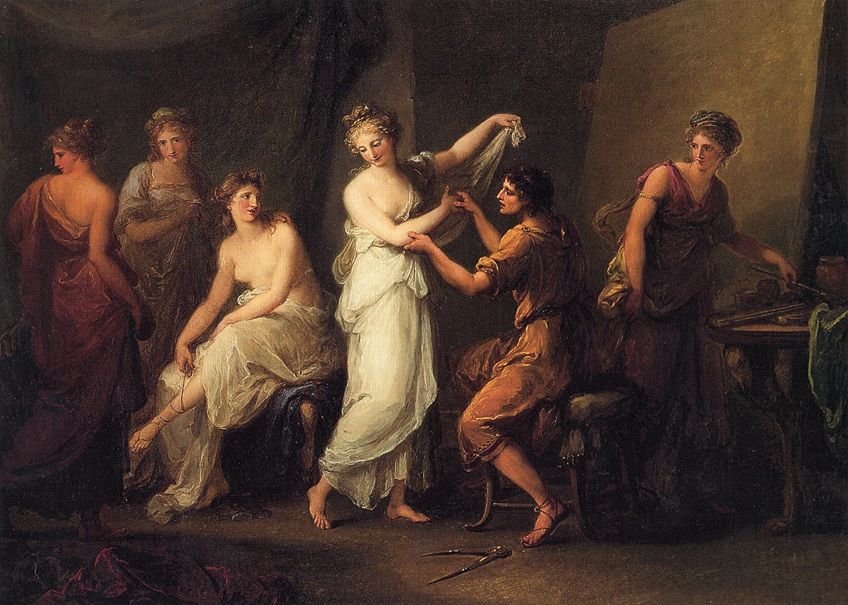 Zeuxis Selecting Models for His Painting of Helen of Troy (c. 1778) past Angelica Kauffmann;Angelica Kauffmann, Public domain, via Wikimedia Commons
Zeuxis Selecting Models for His Painting of Helen of Troy (c. 1778) past Angelica Kauffmann;Angelica Kauffmann, Public domain, via Wikimedia Commons
Famous Ancient Greek Paintings
There are unfortunately very few examples left of original ancient Greek paintings. Nosotros are lucky to have a few original murals and copies created during the Roman era. Let us accept a look at the best examples nosotros accept of classical Greek artwork.
Akrotiri Frescoes (c. 1700 BCE)
| Artist | Unknown |
| Catamenia | c. 1700 BCE |
| Plant | Akrotiri, Thera |
| Electric current Location | National Archeological Museum Athens |
Many of the most well-known images of ancient Greek life that even so exist today are provided to us by the frescoes from the Statuary Age that were plant in Akrotiri on the island of Thera. The town was destroyed by an earthquake old between 1650 and 1550 BCE, followed by a volcanic eruption that covered the entire village in layers of ash and pumice that were meters thick.
I positive aspect of this disaster is that the frescoes take remained largely well preserved due to beingness covered from the elements until excavations started in 1967. In this one surface area alone, several famous fresco paintings were constitute that all deserve to exist noted.
The Ladies Fresco
This fresco was originally situated in Room 2 of the Business firm of the Ladies and is actually ii separate pieces, each 1 depicting a woman. The women are wearing robes and jackets, which display a Minoan influence. Each of the women has long hair, is adorned with jewelry, and is also wearing make-up. The women seem to hold high positions of social condition and seem to be involved in some sort of festival or religious activity. Fragments of a third figure can also be made out. Above them, a starry heaven is depicted.
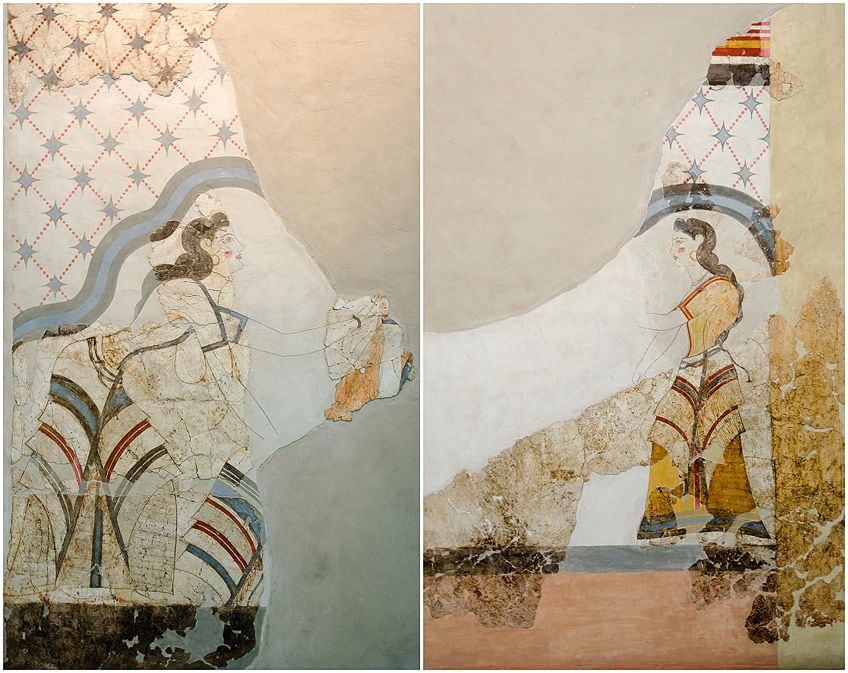 Wall paintings from the Firm of the Ladies found in the Archaeological site of Akrotiri; LEFT: Norbert Nagel, CC By-SA 3.0, via Wikimedia Commons | Correct:Norbert Nagel, CC Past-SA iii.0, via Wikimedia Eatables
Wall paintings from the Firm of the Ladies found in the Archaeological site of Akrotiri; LEFT: Norbert Nagel, CC By-SA 3.0, via Wikimedia Commons | Correct:Norbert Nagel, CC Past-SA iii.0, via Wikimedia Eatables
The Spring Fresco
This fresco depicts lilies or papyrus growing between volcanic rocks while birds tin be seen flying effectually flowers. These flowers are all in various stages of growth and seem to be swaying in the breeze. This fresco originally came from Building Delta, situated in Room two on the ground flooring. Due to the content and context of the plants and birds, it is generally believed to be a depiction of jump, although it is also known every bit the Lilies or Papyrusfresco.
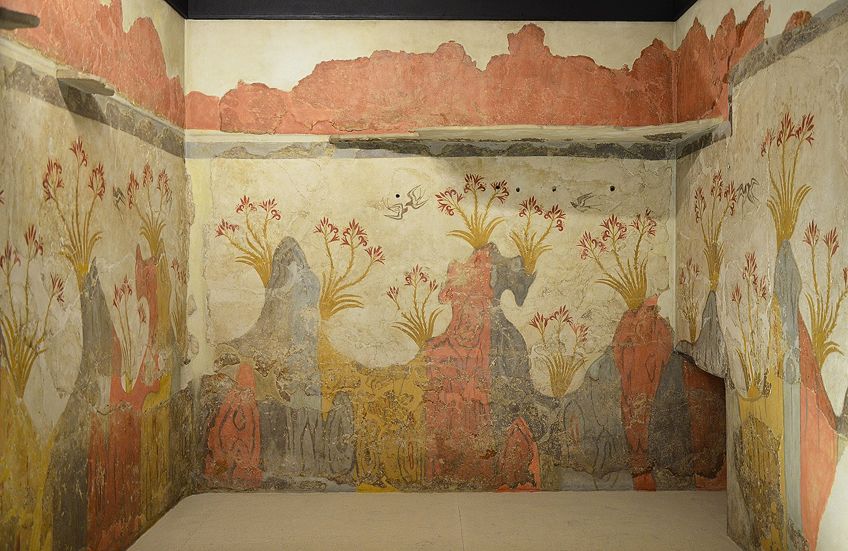 The Spring Fresco, from Akrotiri, Thera (Santorini), Minoan Civilisation, 16th Century BC;Carole Raddato from FRANKFURT, Federal republic of germany, CC BY-SA two.0, via Wikimedia Commons
The Spring Fresco, from Akrotiri, Thera (Santorini), Minoan Civilisation, 16th Century BC;Carole Raddato from FRANKFURT, Federal republic of germany, CC BY-SA two.0, via Wikimedia Commons
The Boxers Fresco
The Boxers fresco portrays two young men battle, which at the time was more of a ritualistic endeavor than a competitive sport. It is situated in Building Beta of the archeological circuitous, in Room B1, and too The Boxers fresco, the other walls are covered in larger frescoes that depict antelopes.
It is known that males are depicted due to the Greek tradition of depicting them in the colour scarlet.
Their hair is long, but there are parts that are shaved, which denotes youth. One figure is adorned with many pieces of jewelry while the other has none. It has been suggested that the playful manner in which the two figures are engaged in gainsay is reflected past the stance of the antelopes on the other walls.
 Battle Children fresco, from Akrotiri, Centre Bronze Age (2000-1600 BC);Jean-Pierre Dalbéra from Paris, France, CC BY 2.0, via Wikimedia Eatables
Battle Children fresco, from Akrotiri, Centre Bronze Age (2000-1600 BC);Jean-Pierre Dalbéra from Paris, France, CC BY 2.0, via Wikimedia Eatables
The Fisherman Fresco
The Fisherman Fresco is regarded as one of the all-time-preserved frescoes establish in Akrotiri and was originally in the Due west House, situated in the corner of Room 5. The fresco depicts a human conveying fish in his hands, which have been arranged together with yellow string.
A very similar painting can be found on an bordering wall, with both male person figures being depicted equally naked and with partially shaven heads.
Due to these details, it has been suggested that they are portrayed performing some kind of religious ritual. Another detail that points at the ritualistic intent of the paintings lies in the fact that both figures face the northwest corner of the room, the verbal place where archeologists had constitute a table meant for offerings.
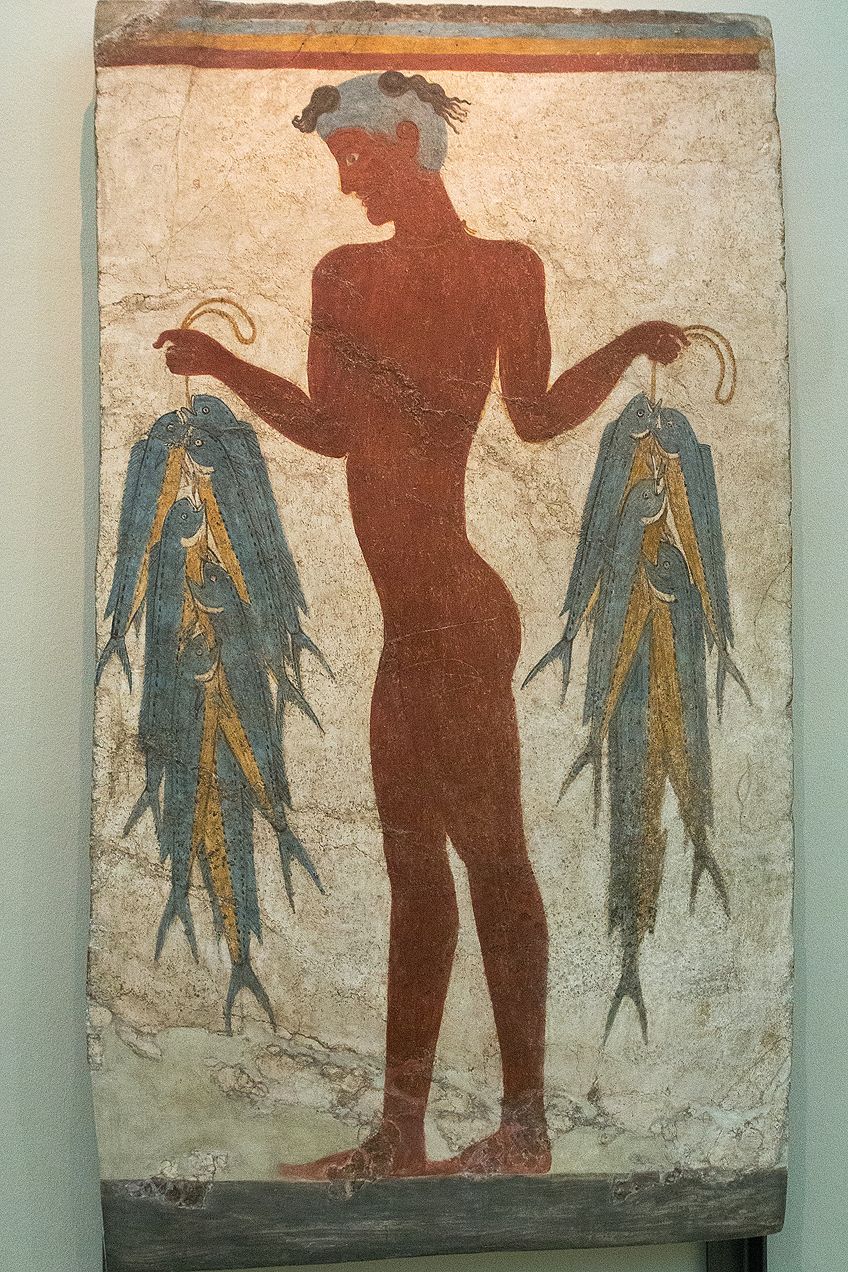 The Fisherman Fresco from Akrotiri on the island of Thera (Santorini). The male may really be a youth offering fish every bit function of a religious anniversary rather than a fisherman. From Room v of the W House, 17th century BCE;Zde, CC BY-SA 4.0, via Wikimedia Eatables
The Fisherman Fresco from Akrotiri on the island of Thera (Santorini). The male may really be a youth offering fish every bit function of a religious anniversary rather than a fisherman. From Room v of the W House, 17th century BCE;Zde, CC BY-SA 4.0, via Wikimedia Eatables
Blue Monkeys Fresco
This fresco was originally situated in Room B6 and although fragmented, the delineation can notwithstanding be made out. Portrayed are several blue monkeys climbing rocks to avert the two dogs that are chasing them. Monkeys were often mythologically represented every bit attendants to priestesses, but the depictions could too take been of real monkeys, every bit fossilized skulls had been found on the isle.
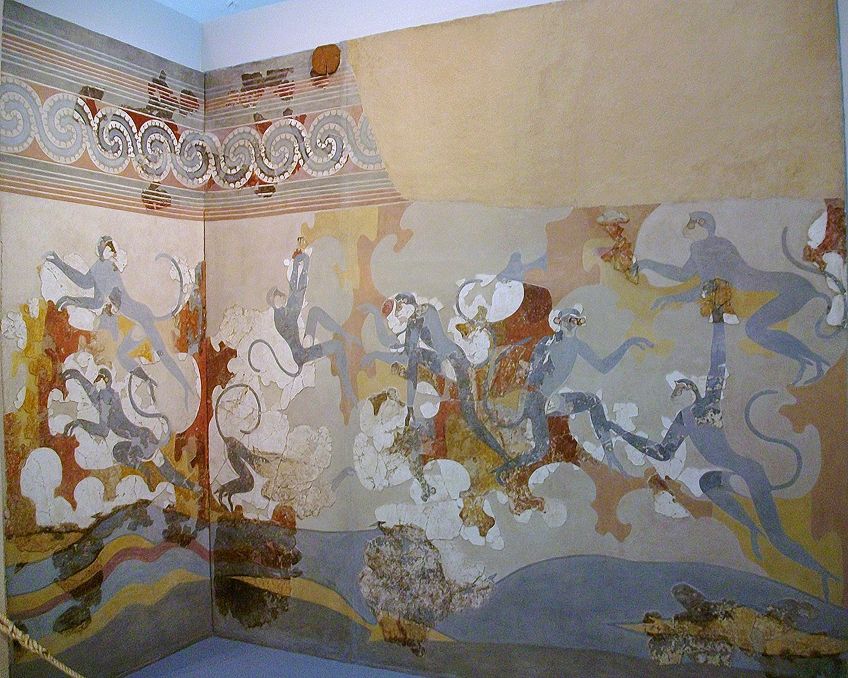 Blueish Monkeys fresco, Akrotiri, 17th century BC, Thira Museum of Prehistory;Joanbanjo, CC Past-SA 3.0, via Wikimedia Eatables
Blueish Monkeys fresco, Akrotiri, 17th century BC, Thira Museum of Prehistory;Joanbanjo, CC Past-SA 3.0, via Wikimedia Eatables
Pitsa Panels (c. 540 – 530 BCE)
| Artist | Unknown |
| Menses | c. 540 – 530 BCE |
| Plant | Pitsa, Corinthia, Greece |
| Current Location | National Archeological Museum, Athens |
These ancient Greek paintings are the oldest panel paintings from Greece to still be in existence. These wooden painted tablets were found at a site near Pitsa, Corinthia, discovered in a nearby cave in the 1930s. They were all in various states of decay with two of them being extremely fragmented when found.
Stylistically, they accept been dated to the tardily Greek Archaic period of fine art, around 540 to 530 BCE. The panels are made from thin boards made of wood and have been covered with plaster before being painted on with pigments fabricated from various minerals. The colors of the panels remain bright and well preserved, with merely eight colors used in total with no gradation or shading.
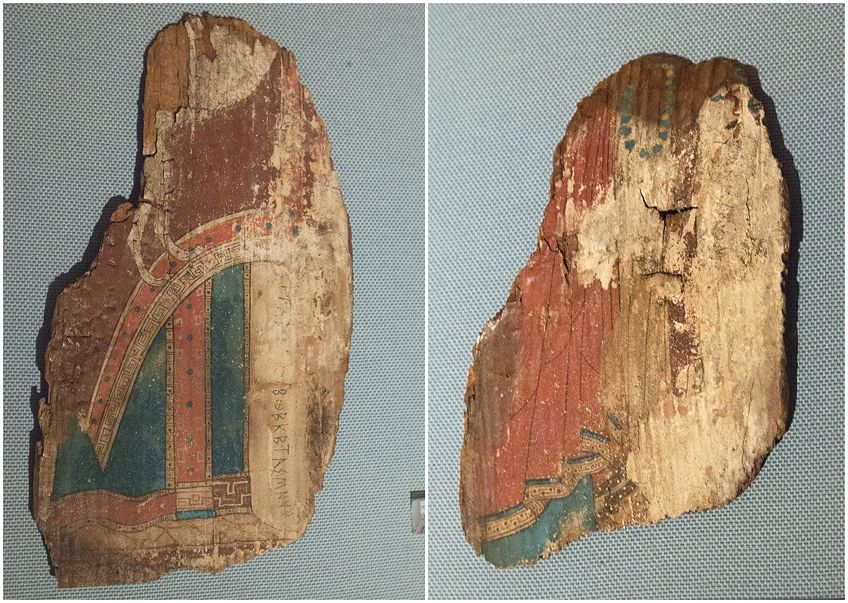 Painted wooden plaques found about ancient Sikyon, in a cavern above the hamlet Pitsa in Corinthia. LEFT: Fragment of a large plaque, lower part, 540-530 BC. National Archaeological Museum of Athens;Zde, CC By-SA 4.0, via Wikimedia Commons| RIGHT: Fragment of a large plaque with richly draped himation. Dedicated to the nymph in the Corinthian alphabet, 525-500 BC. National Archaeological Museum of Athens;Zde, CC Past-SA 4.0, via Wikimedia Commons
Painted wooden plaques found about ancient Sikyon, in a cavern above the hamlet Pitsa in Corinthia. LEFT: Fragment of a large plaque, lower part, 540-530 BC. National Archaeological Museum of Athens;Zde, CC By-SA 4.0, via Wikimedia Commons| RIGHT: Fragment of a large plaque with richly draped himation. Dedicated to the nymph in the Corinthian alphabet, 525-500 BC. National Archaeological Museum of Athens;Zde, CC Past-SA 4.0, via Wikimedia Commons
It has been suggested that the nighttime outlines were drawn get-go before filling them in with colors such as red, blue, green, brown, and royal, also as black and white.
The panels portray scenes of religious context that are connected with the lesser nature deities known every bit nymphs. One of the panels that are non fragmented depicts the scene of a sacrifice to the nymphs. Three feminine figures dressed in traditional Greek robes tin can be seen walking towards the altar on the correct. Musicians back-trail them playing instruments such as the Aulos and the Lyra.
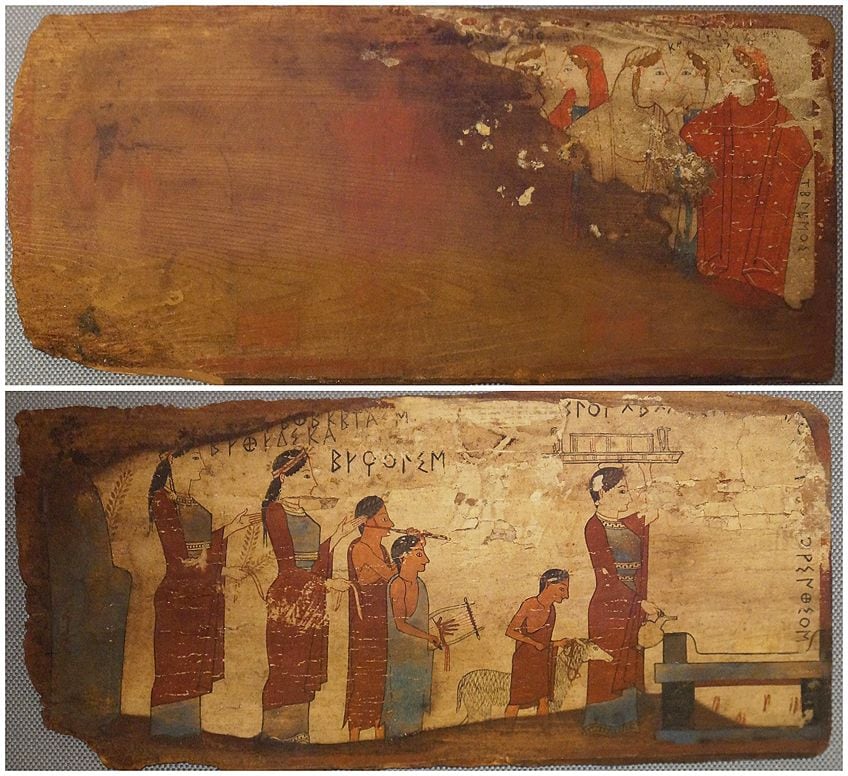 Pitsa panels at the National Archaeological Museum of Athens. TOP: NAMA 16467; Schuppi, CC BY-SA 4.0, via Wikimedia Eatables | Lesser: NAMA 16464;Schuppi, CC BY-SA four.0, via Wikimedia Commons
Pitsa panels at the National Archaeological Museum of Athens. TOP: NAMA 16467; Schuppi, CC BY-SA 4.0, via Wikimedia Eatables | Lesser: NAMA 16464;Schuppi, CC BY-SA four.0, via Wikimedia Commons
A ritual pouring is beingness performed by the figure closest to the altar. A sacrificial lamb is beingness led past a slave figure behind her. The tablet inscription states that the panels were created in honor of the nymphs and two women are named equally dedicators, Eucholis and Euthydikos.
These panels were connected to a cult that was widespread throughout ancient Greece, which involved making offerings and sacrifices to the divine nature beings.
Achilles and Ajax Playing(540 – 530 BCE)
| Artist | Exekias (mid-6th century BC) |
| Menstruum | 540 – 530 BCE |
| Institute | Gregorian Etruscan Museum |
| Electric current Location | Vatican Museum, Rome |
Exekias was an aboriginal Greek painter and potter who worked in Athens old betwixt 545 BCE and 530 BCE. He is regarded as the greatest Attic painter due to his highly detailed artwork created using dirt slips that had been fired until black and then worked on by a complex incision technique. This black-figure technique was the most common method used by Exekias to create his compositions, which have been termed "psychologically sensitive".
2 other Attic vase painters that were thought to exist students of Exekias are the Lysippides Painter and the Andokides Painter, both of whom'due south true identities remain unknown to historians.
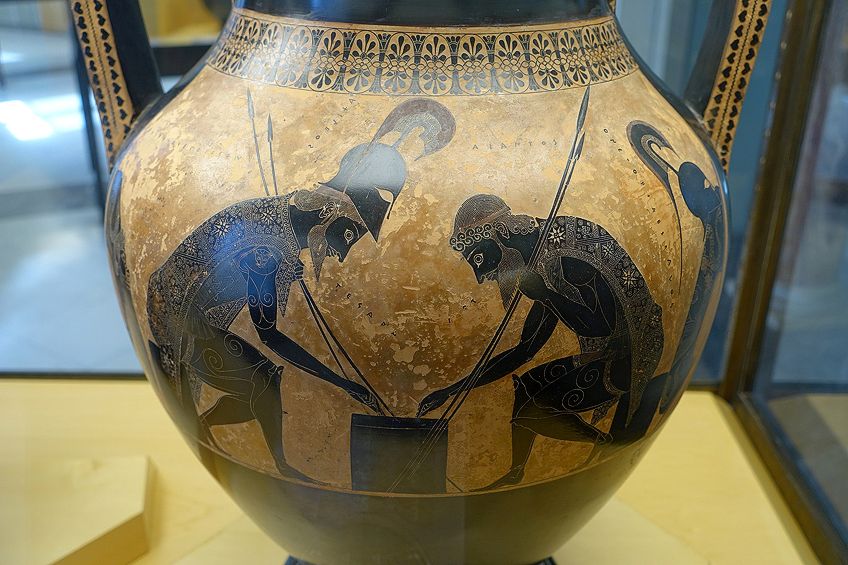 Attic black-figured amphora signed by Exekias as both painter and potter, depicting Achilles and Ajax playing a game during the Trojan State of war, 540-530 BC;Daderot, Public domain, via Wikimedia Commons
Attic black-figured amphora signed by Exekias as both painter and potter, depicting Achilles and Ajax playing a game during the Trojan State of war, 540-530 BC;Daderot, Public domain, via Wikimedia Commons
The vase depicting Achilles and Ajax is regarded equally Exekias'south greatest piece of work and shows the 2 figures of Greek legend involved in playing a game that this thought to exist similar to checkers or backgammon. Although they are busy playing a game, they are depicted wearing armor and carrying spears, a sign that they are most likely taking a break from military duty and may peradventure be called back into battle at any time. There are no historical records of the 2 ever having sat down to play a game, so this painting is seen as more of a symbolic representation of the Trojan War.
Despite this being a scene made upwards by the artist, information technology is ane that has been reproduced over 150 times in the 50 years that followed its creation.
Euphronios Krater (c. 515 BCE)
| Artist | Euphronios (late 6th century BC) |
| Period | c. 515 BCE |
| Found | Greppe Sant'Angelo |
| Current Location | Archaeological Museum of Cerveteri |
The Euphronios Krater is a terracotta vase used for mixing water with vino in ancient Greece. Considered one of the finest painted vases in existence, it was created by the renowned Greek painter and potter Euphronius, and it is the last example however in beingness of the 27 vases that he created and painted. From 1972 until 2008, information technology was held at the Metropolitan Museum of Art but was moved to the Archeological Museum of Cerveteri post-obit agreements to take stolen artworks repatriated to their countries of origin. The vase has a diameter of 55 cm and a acme of 45 cm and can concur effectually 45 liters of liquid.
Stylistically, the vase belongs to the group of vases known as red-effigy pottery, where the figures are left the natural colour of the terracotta clay, but the details and backgrounds are rendered with blackness slips.
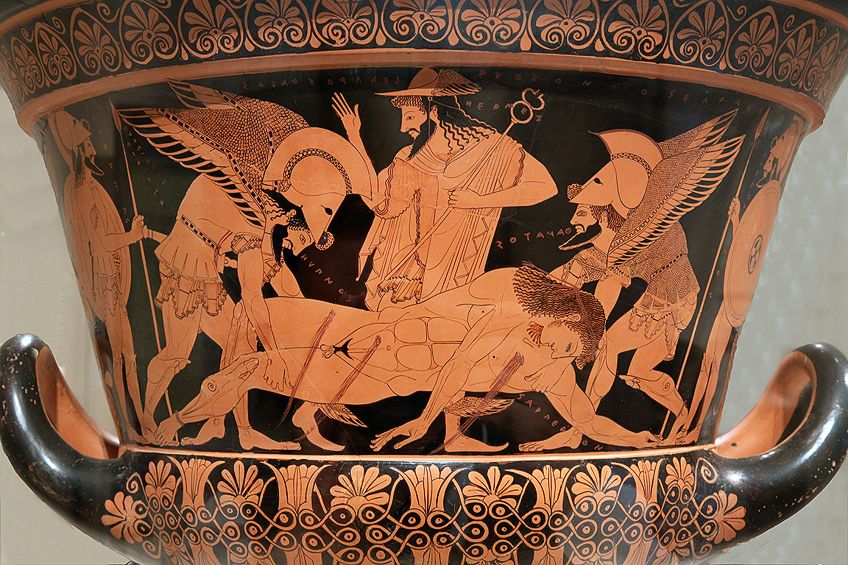 Sarpedon's body carried by Hypnos and Thanatos (Sleep and Death), while Hermes watches. Side A of the so-chosen "Euphronios krater", Cranium red-figured calyx-krater signed by Euxitheos (potter) and Euphronios (painter), ca. 515 BC;Jaime Ardiles-Arce (photographer). Krater by Euphronios (painter) and Euxitheos (potter)., Public domain, via Wikimedia Commons
Sarpedon's body carried by Hypnos and Thanatos (Sleep and Death), while Hermes watches. Side A of the so-chosen "Euphronios krater", Cranium red-figured calyx-krater signed by Euxitheos (potter) and Euphronios (painter), ca. 515 BC;Jaime Ardiles-Arce (photographer). Krater by Euphronios (painter) and Euxitheos (potter)., Public domain, via Wikimedia Commons
On one side of the Euphronios Krater is the delineation of an episode from the Trojan War in which the son of Zeus, Sarpedon, is portrayed dying. Hermes is depicted directing Hypnos and Thanatos to take the fallen hero back to his homeland so that he may be buried.
On the other side of the Euphronios Krater is a scene depicting several young men of Athens preparing themselves for battle by putting on various pieces of armor. The employ of naturalistic poses and the dramatic apply of two scenes on 1 artwork are considered characteristics of the late Primitive painters known as the Pioneer Group, of which Euphronios was considered to exist the virtually renowned and accomplished.
The opposing themes of aboriginal and contemporary, likewise equally mythological and historical, were blurred in the painted vases from the Pioneer Group.
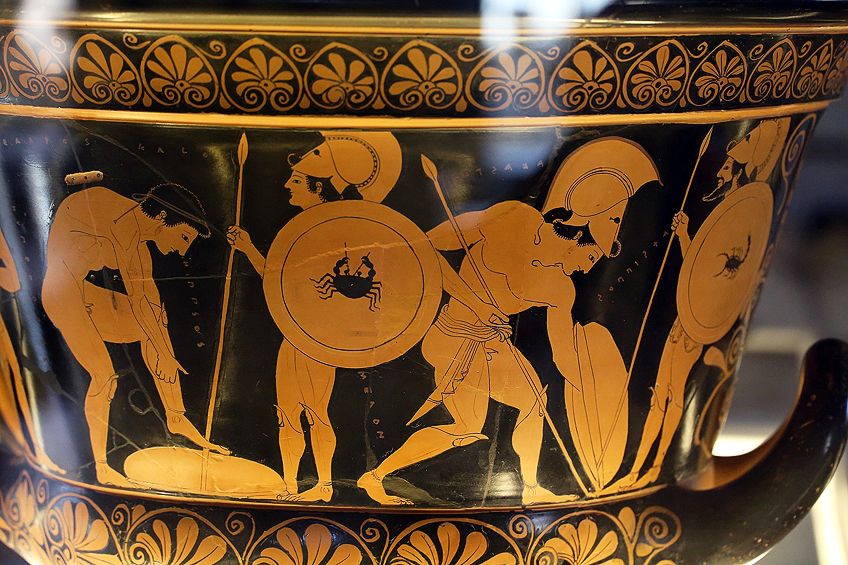 Athenian youths arming themselves. Side B of the so-chosen "Euphronios krater", Attic cherry-red-figured calyx-krater signed by Euxitheos (potter) and Euphronios (painter), ca. 515 BC;Sailko, CC Past 3.0, via Wikimedia Commons
Athenian youths arming themselves. Side B of the so-chosen "Euphronios krater", Attic cherry-red-figured calyx-krater signed by Euxitheos (potter) and Euphronios (painter), ca. 515 BC;Sailko, CC Past 3.0, via Wikimedia Commons
Tomb of the Diver at Paestum (c. 470 BCE)
| Creative person | Unknown |
| Flow | 470 BCE |
| Found | Paestum, Magna Graecia |
| Electric current Location | Museum of Paestum |
The Tomb of the Diver is a Greek archeological monument establish in 1968 by Mario Napoli, an Italian archeologist, during an earthworks of a cemetery situated close to the city of Paestum. The tomb was made from v locally-sourced slabs of limestone, which formed the ceiling and walls, while the flooring was natural bedrock. The walls were then bonded in plaster and painted in the fresco technique.
The walls depict a symposium scene, where traditionally after eating, Greeks would entertain themselves with dancing, drinking, and other leisurely activities. The cover slab depicts a man diving into a stream of h2o, hence where the proper noun of the tomb came from.
These frescoes are considered extremely rare and important as they are the only remaining examples of Greek paintings portraying figured scenes that could be dated as far dorsum as the Archaic and Classical periods. Furthermore, these frescoes accept survived in their original country without beingness fragmented.
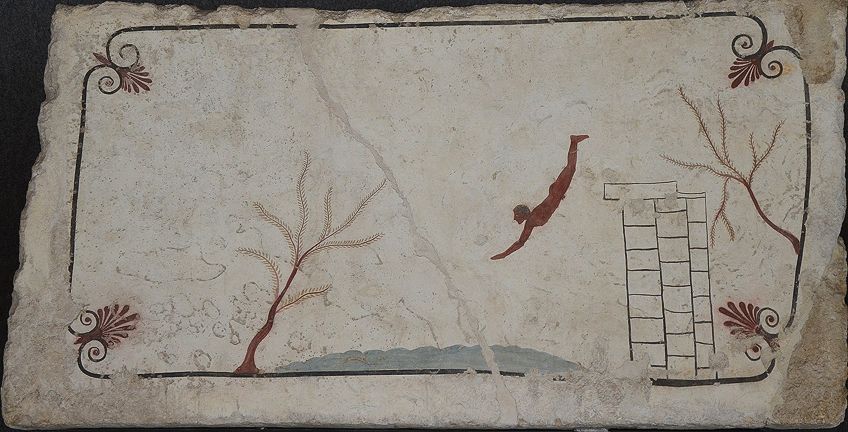 The Diver, painting from the covering slab of the Tomb of the Diver, 470 BC, Paestum Archaeological Museum;Carole Raddato from FRANKFURT, Germany, CC BY-SA 2.0, via Wikimedia Eatables
The Diver, painting from the covering slab of the Tomb of the Diver, 470 BC, Paestum Archaeological Museum;Carole Raddato from FRANKFURT, Germany, CC BY-SA 2.0, via Wikimedia Eatables
During the menses from 700 to 400 BCE, in that location were thousands of tombs that were created and busy, but this is the only one that featured human being figures in the frescoes.
Paestum was well situated to be influenced by the paintings of the Etruscan tombs, as it was only a few miles from the Greek edge with the Etruscan zones. Although tomb wall painting was a common practise, very few examples still remain today. But a few objects were found in the tomb'due south interior besides the occupant's skeleton, including a small spherical flask used for perfumes, an Attic vase, and a turtle shell. Due to the presence of the Cranium vase, they were able to date the tomb to effectually 470 BCE.
The Siren Vase (480 – 470 BCE)
| Artist | The Siren Painter (c. fifth century BC) |
| Period | c. 480 – 470 BCE |
| Found | Vulci |
| Current Location | British Museum |
This ancient Greek artwork is assumed by scholars to be the piece of work of the Siren Painter. This title was given to an aboriginal Greek painter who created and painted Attican vases but never signed his work. The artist's birth appointment and death date, every bit well as their identity, remain a mystery. The creative person was named after the red-figured vases he created, such as The Siren Vase, which depicts a scene from Homer's Odyssey.
It is thought that the Siren Painter was agile around 480 to 470 BCE, and a few of their works are on public display at various museums.
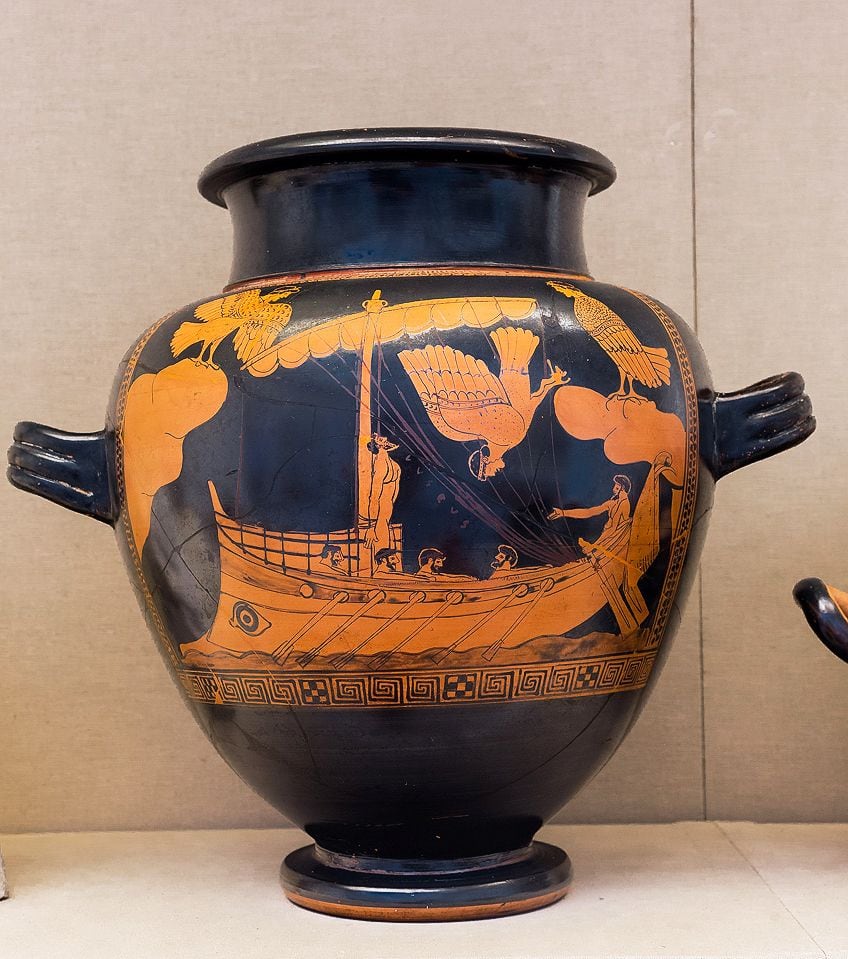 Attic red-figured vase, side A. Odysseus, bound onto the mast of his ship, passes the Sirens. Painted past the Siren Painter, Athens, ca. 475-470 BC;ArchaiOptix, CC By-SA 4.0, via Wikimedia Eatables
Attic red-figured vase, side A. Odysseus, bound onto the mast of his ship, passes the Sirens. Painted past the Siren Painter, Athens, ca. 475-470 BC;ArchaiOptix, CC By-SA 4.0, via Wikimedia Eatables
In this red-figured vase, Odysseus's ship is passing by the sirens. The waves accept been depicted with a wavy outline in the foreground that has been shaded with a thinned black. 5 bearded figures tin exist seen manning the oars as the ship heads towards the left of the composition. Another effigy can be seen on the ship's stern encouraging the oarsmen.
Odysseus tin can be seen fastened to the bottom of the mast, with his arms lashed behind his dorsum, facing the stern. His head is positioned looking upwards at the siren. On either side of the ship are rocky cliffs with a Siren perched on the edge of each i.
The Sirens are depicted as having bird'due south bodies and the heads of human being females. Their lips have been illustrated equally beingness slightly parted, indicating that they are singing.
Philip II Tomb (c. quaternary century BCE)
| Artist | Unknown |
| Period | c. quaternary century BCE |
| Constitute | Vergina Tomb |
| Electric current Location | Museum of the Imperial Tombs, Vergina |
Today, Vergina is a pocket-size and rather unremarkable village that is situated around l miles westward of Thessaloniki. Still, information technology was once a prominent metropolis in the Macedonian kingdom known as Aigai. Information technology is here that we find the tomb of Philip Ii, which is home to ii famous Greek paintings.
Philip II and Alexander the Great Facade Painting
The front part of the tomb was sealed with a stone door flanked by a column on either side. The most remarkable aspect of the tomb's facade is the painting that runs across the surface. Despite beingness in very poor condition, it is one of the only examples of aboriginal Greek paintings to still be. It portrays a hunting scene with two people on horseback, most probable father and son, Philip II and Alexander the Dandy.
 Wall painting of Phillip Ii and Alexander the Peachy on the facade of the royal tomb at Verghina (Vergina), Macedonia, quaternary century BC; Unknown author Unknown author, CC Past-SA 2.0, via Wikimedia Eatables
Wall painting of Phillip Ii and Alexander the Peachy on the facade of the royal tomb at Verghina (Vergina), Macedonia, quaternary century BC; Unknown author Unknown author, CC Past-SA 2.0, via Wikimedia Eatables
Hades Abducting Persephone
Some other famous fresco that tin be found in the tomb is that of Hades abducting Persephone. Although the paint has deteriorated profoundly since this fresco was originally created, the mythological scene tin still exist made out. In the scene, Hades can be seen in a red chariot in the human action of abducting the goddess Persephone. Special attention has been put into creating the details of the material that covers her abdomen. In the bottom correct-hand corner of the canvas, a nymph that was attending to the goddess tin can be seen cowering away in fright of the storming chariot.
And that concludes our listing of famous ancient Greek paintings! Despite there beingness about no existing examples of the work created past ancient Greek painters, they still managed to have an influence on the movements that followed them for an extremely long time. The techniques that the very early pioneers of the Greek arts first created prepare the standard for many generations to come. Although about of the paintings accept been lost to time, there are yet a few examples that exist in places like tombs and the walls of buildings, frozen in time due to events such as earthquakes and volcanic eruptions. Later having been covered in ash and depris for centuries, these Greek paintings have since been rediscovered and appreciated for the insight they provided into ancient Greek life.
Take a look at our famous Greek paintings webstory here!
Oft Asked Questions
What Was Significant About Greek Paintings?
Classical Greek artwork represented the height of man accomplishment at its fourth dimension. Despite there being nearly no ancient greek paintings left in the modernistic era, the influence that early artists such as Cimon of Cleone, Agatharcus, Apollodorus, and Zeuxis set the standards for the artists that followed. These ancient Greek painters fabricated use of breakthrough techniques such as foreshortened perspective, visual illusions, accurate displays of human being anatomy, and the use of shading and shadows to create more three-dimensional paintings.
Where Tin Ancient Greek Paintings Still Be Seen?
Sure mediums used to create aboriginal Greek artworks accept managed to withstand the hardships of time due to being fabricated from stone, marble, bronze, and other resilient materials. Therefore, Greek sculptures tin be found in many museums. Painting, however, is a medium that deteriorates very apace and the only remaining examples are those that were painted onto walls instead of canvases, as well as the few Attic-style vases that accept managed to survive. At that place are likewise many remaining fragments of pigment that have been establish on ancient statues, which means that many sculptures that we assumed were left naturally colored were actually in one case ornately painted, but take over the centuries faded away. Due to paint traces, modern art scholars are able to reproduce the colors that ancient Greek painters used in order to reproduce some of the Classical Greek artworks that still remain today. Today, the last few examples can be found in various museums in Hellenic republic and around the globe.
Source: https://artincontext.org/greek-paintings/
0 Response to "Most Greek Paintings Still Exist Today and Are in Art Museums"
Post a Comment